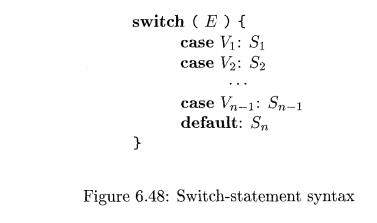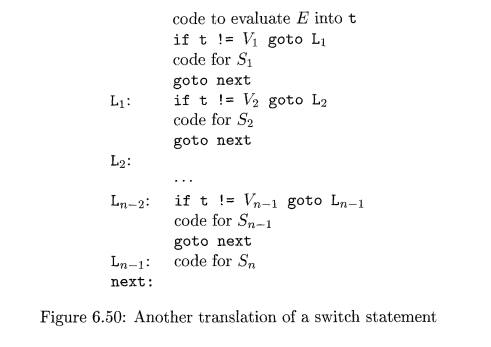Chapter: Compilers : Principles, Techniques, & Tools : Intermediate-Code Generation
Switch-Statements
Switch-Statements
1 Translation of
Switch-Statements
2 Syntax-Directed Translation of
Switch-Statements
3 Exercises for Section 6.8
The "switch" or "case" statement is available in a
variety of languages. Our switch-statement syntax is shown in Fig. 6.48. There
is a selector expression E, which is
to be evaluated, followed by n constant
values Vi, V2, • • • ,Vn that the expression might
take, perhaps including a default
"value," which always matches the expression if no other value does.

1. Translation of
Switch-Statements
The intended translation of a switch is code to:
Evaluate the expression E.
Find the value V} in the list of cases that is the same as the value of
the expression. Recall that the default value matches the expression if none of
the values explicitly mentioned in cases does.
3. Execute the statement Sj associated with the value found.
Step (2) is an n-way branch,
which can be implemented in one of several ways. If the number of cases is
small, say 10 at most, then it is reasonable to use a sequence of conditional
jumps, each of which tests for an individual value and transfers to the code
for the corresponding statement.
A compact way to implement this
sequence of conditional jumps is to create a table of pairs, each pair
consisting of a value and a label for the corresponding statement's code. The
value of the expression itself, paired with the label for the default statement
is placed at the end of the table at run time. A simple loop generated by the
compiler compares the value of the expression with each value in the table,
being assured that if no other match is found, the last (default) entry is sure
to match.
If the number of values exceeds
10 or so, it is more efficient to construct a hash table for the values, with
the labels of the various statements as entries. If no entry for the value
possessed by the switch expression is found, a jump to the default statement is
generated.
There is a common special case that can be
implemented even more effi-ciently than by an n-way branch. If the values all
lie in some small range, say min to max, and the number of different values
is a reasonable fraction of max — min, then
we can construct an array of max — min "buckets,"
where bucket j — min contains the label of the statement with value j; any bucket that would otherwise
remain unfilled contains the default label.
To perform the switch, evaluate the expression to
obtain the value j; check that it is
in the range min to max and transfer indirectly to the table
entry at offset j — min. For example,
if the expression is of type character, a table of, say, 128 entries (depending
on the character set) may be created and transferred through with no range
testing.
2. Syntax-Directed Translation of
Switch-Statements
The intermediate code in Fig. 6.49 is a convenient translation of the
switch-statement in Fig. 6.48. The tests all appear at the end so that a simple
code generator can recognize the multiway branch and generate efficient code
for it, using the most appropriate implementation suggested at the beginning of
this section.

The more straightforward sequence
shown in Fig. 6.50 would require the compiler to do extensive analysis to find
the most efficient implementation. Note that it is inconvenient in a one-pass
compiler to place the branching statements at the beginning, because the
compiler could not then emit code for each of the statements Si as it saw them.
To translate into the form of
Fig. 6.49, when we see the keyword switch, we generate two new labels test and next, and a new temporary t. Then,
as we parse the expression E, we
generate code to evaluate E into t. After processing E, we generate the jump goto test.
Then, as we see each case keyword, we create a new label Li
and enter it into the symbol table. We place in a queue, used only to store
cases, a value-label pair consisting of the value Vi of the case constant and Li
(or a pointer to the symbol-table entry for Li).
We process each statement case Vi: Si by emitting the label Li attached to the code for Si, followed by the jump goto next.

When the end of the switch is found, we are ready to generate the code
for the n-way branch. Reading the queue of value-label pairs, we can generate a
sequence of three-address statements of the form shown in Fig. 6.51. There, t is the temporary holding the value of
the selector expression E, and hn is the label for the default statement.

The case t Vi Li instruction
is a synonym for if t = Vi goto Li in Fig. 6.49, but the case
instruction is easier for the final code generator to detect as a candidate for
special treatment. At the code-generation phase, these sequences of case
statements can be translated into an n-way branch of the most efficient type,
depending on how many there are and whether the values fall into a small range.
3. Exercises
for Section 6.8
Exercise 6.8.1 : In order to translate a switch-statement into
a sequence of case-statements as in Fig. 6.51, the translator needs to create
the list of value label pairs, as it processes the source code for the switch.
We can do so, using an additional translation that accumulates just the pairs.
Sketch a syntax-direction definition that produces the list of pairs, while
also emitting code for the statements Si
that are the actions for each case.
Related Topics